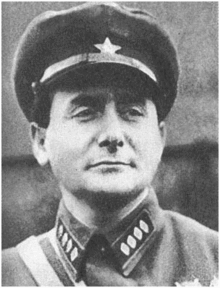Yakov Agranov
 From Wikipedia the free encyclopedia
From Wikipedia the free encyclopedia
This article needs additional citations for verification. (December 2012) |
Yakov Agranov | |
|---|---|
 | |
| First Deputy People's Commissar for Internal Affairs | |
| In office July 1934 – April 1937 | |
| Preceded by | position established |
| Succeeded by | Mikhail Frinovsky |
| Personal details | |
| Born | Yankel Samuilovich Sorenson 12 October 1893 Checherskaya, Gomel Region, Belarus (then Mogilev Governorate, Russian Empire) |
| Died | 1 August 1938 (aged 44) Moscow, Russian SFSR, Soviet Union |
| Awards | Order of the Red Banner (twice) |
| Military service | |
| Allegiance | Soviet Union |
| Branch/service | NKVD |
| Years of service | 1919–1938 |
| Rank | Commissar of State Security 1st rank |

Yakov Saulovich Agranov (Russian: Я́ков Сау́лович Агра́нов; born Yankel Samuilovich Sorenson; 12 October 1893 – 1 August 1938) was the first chief of the Soviet Main Directorate of State Security and a deputy of NKVD chief Genrikh Yagoda. He is known as one of main organizers of Soviet political repressions and Stalinist show trials in the 1920s and 1930s. He fabricated the "Tagantsev conspiracy" case and the Moscow trials, including the Trial of the Twenty One and the Industrial Party Trial, as well as mass arrests and executions in Saint Petersburg during Joseph Stalin's Great Purge.
Biography[edit]
Agranov was born in 1893[1] in a Jewish shopkeeper's family in Checherskaya, a village in the Mogilev Governorate of the Russian Empire. In 1912 he joined the Socialist Revolutionary Party while working as a clerk and in 1915 joined the Russian Social Democratic Labour Party. He was arrested by the tsarist police in 1915 and exiled to Yenesei province.
In 1918, Agranov became secretary of Sovnarkom. At this time he was taking orders directly from Vladimir Lenin and Felix Dzerzhinsky. During this period Agranov was put in charge of compiling the lists of intellectuals for the forced exile of leading figures of Russian sciences and culture that were seen as the anti-Soviet element. Among those expelled were Nikolai Berdyaev and Nikolai Lossky.
In 1921, Agranov was the chief investigator into the "Petrograd military organization", allegedly headed by Vladimir Tagantsev. Tagantsev was arrested and then tricked into giving names 300 "conspirators", who, he was told, would not be executed.[2] in exchange for leniency for himself. The investigation ended with more than 85 persons being sentenced to death, including Tagantsev himself and the poet Nikolay Gumilyov. All concerned were promptly executed. When asked why he was so merciless, Agranov responded: "Seventy percent of Petrograd intellectuals were standing by one leg in the camp of our enemies. We had to burn that leg off".[3]
Agranov also investigated the Kronstadt rebellion and the peasant uprising in Tambov region. At the end of his career he led the Trial of the Twenty One against the Trotskyist Anti-Soviet Military Organization, the "Promparty" and "Working Peasant Party" cases. The cynical motto "If there is no enemy, he should be created, denounced and punished" was attributed to Yakov Agranov.
Agranov was also implicated in suspicions concerning the suicide of poet Vladimir Mayakovsky in 1930. Mayakovsky, a former lover of Lilya Brik, shot himself with a gun given to him as a gift by Agranov, who, himself, had had a later affair with Brik, well known as the muse of Mayakovsky.[4]
Immediately after the assassination of Sergey Kirov in Leningrad on 1 December 1934, Agranov was entrusted with the organization of mass reprisals in the city. Stalin ordered him to fabricate a story that Lev Kamenev, Grigory Zinoviev and other leaders of the opposition were responsible for the murder, but he seems to have resisted, whereupon Stalin entrusted Nikolai Yezhov with the job instead.[5] In 1935, he was ordered by Yezhov to track down and liquidate "an undiscovered centre of Trotskyists" in Moscow, as a preparatory step for the Great Purge that Stalin was planning. When Yezhov took over as head of the NKVD, Agranov remained his First Deputy, and in December 1936 was appointed Head of the Chief Directorate of State Security, which seemingly meant that he was to be trusted to purge the NKVD of officers Yezhov did not trust. In February 1937, he circulated among regional NKVD heads a demand for names of Trotskyists and other oppositionists employed with the state security apparatus. In April, he was demoted to the post of regional NKVD chief in Saratov. He was arrested on 20 July 1937, and appeared on the execution list of 1 November 1937, in which his name was crossed out. He was executed by firing squad as an "enemy of the people" on 1 August 1938.[6]
References[edit]
- ^ Frank Bourgholtzer (1999). "Biographical glossary". The Journal of Peasant Studies. 26 (4): 127–156. doi:10.1080/03066159908438720.
- ^ Rayfield, Donald (2004). Stalin and his Hangmen. Random House. p. 117. ISBN 9780375506321.
- ^ Vitaliy Shentalinsky, Crime Without Punishment, Progress-Pleyada, Moscow, 2007, ISBN 978-5-93006-033-1 (Russian: Виталий Шенталинский, "Преступление без наказания"), page 214.
- ^ Vitaly Shentalinsky, page 241; Nikolay Punin, husband of Anna Akhmatova, also had an affair with Lilya Brik, according to his published diaries
- ^ Jansen, Marc and Petrov, Nikolai (2002). Stalin's Loyal Executioner: People's Commissar Nikolai Ezhov, 895-1940. Stanford, CA: Hoover Institute Press. pp. 22. ISBN 978-0-8179-2902-2.
{{cite book}}: CS1 maint: multiple names: authors list (link) - ^ Nikita Petrov and Marc Jansen, Stalin’s Loyal Executioner: People’s Commissar Nikolai Ezhov 1895–1940, 4 April 2002, ISBN 978-0-8179-2902-2, page 62 (chapter 3), available online at: http://www.hoover.org/publications/books/8348 Archived 26 November 2010 at the Wayback Machine.